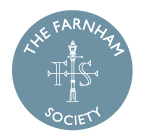Brightwells Yard
A long history
BRIGHTWELLS YARD DEVELOPMENT:
‘The best laid schemes o’ mice an men gang aft a-gley.’
The Brightwells Yard development arose from an ambitious design brief, ‘East Street Area of Opportunity’ published early in 2000. It was based upon high street trade in the 1990s – pre the banking crisis of 2008 and the slow inevitable decline of shopping as a physical activity with the growth of the ubiquitous on line solution for all needs. Covering an area of 5.4 ha (13.4 acres) it included the Woolmead, the leisure centre and the Sainsbury store.

The scheme as eventually adopted is somewhat less ambitious, and was forced through despite many thousand objections. A major concern was the danger of Farnham becoming bifurcated. Without pedestrianisation of the town centre, there will not be free movement of pedestrians between the existing shopping area (The Borough, Castle Street, West Street and Downing Street) and the new Brightwells Yard. This will result in two separate retail areas there is a risk that only one will survive. We could see the risk of a prosperous and attractive West end and a deprived, empty and increasingly desolate East end. The scheme includes 239 apartments (many of them small) but there has been inadequate attention to infrastructure required so that a small town can sustain the new residents as well as their visitors. The low provision of parking spaces risks causing increased congestion, for example if residents’ visitors use the 42 streets of unrestricted parking in Farnham to save them paying in nearby council carparks !
The Brightwells development journey had inauspicious beginnings. Multiple schemes were put forward in response to the 2000 design brief, a public consultation followed, but the most popular scheme was not adopted. Instead, Waverley selected the scheme put forward by the Crest Nicholson – Sainsbury (CNS) partnership. This was less ambitious than the original design brief, covering 4.3 ha (10.8 acres). Michael Blower presented a creative and vibrant alternative development vision in August 2002 at The Bush Hotel: it was ignored. By 2003 Waverley and CNS signed as partners, making Waverley at the same time land owner, developer and planning authority – raising concerns over possible conflict of interest.

In 2008, the scheme was reduced to its present size, 3.95 ha /9.8 acres. Sainsbury had left the partnership with Crest Nicholson, and the
Sainsbury store and car park were removed from the scheme. The reduced site comprised mostly land owned by Waverley, but some was under commercial ownership and had to be acquired by Compulsory Purchase Order. This included the Marlborough Head, the adjacent car park, and the health centre between Dogflud car park and Redgrave. The whole plot was to be sold to the developer for £8.76M. A new planning application was submitted, and consent was granted in 2009 despite more than 5800 objections. In addition to reasons cited above for objections, there was concern that the development would be higher and more massive than anything already in the town centre, giving rise to a site quite unsuited to a market town.

At a public enquiry in 2013 into the Compulsory Purchase Order, Waverley insisted finance was secured and the site ‘shovel ready’. However when the enquiry allowed Waverley to proceed it was announced that finance was unavailable!
In 2016, the purchase price for the land was reduced from £8.76M to £3.19M, this being less that the sum paid for compulsory purchase (£4.5M).
A group of Farnham residents and councillors then sought a Judicial Review into the management of the development contract. When a public sector scheme goes out to tender, procedure requires that in the event of significant changes to the scheme which benefit the contractor, it should be retendered Waverley had not retendered in spite of substantial changes. On the precedent of a development in Winchester, the local group sought a Judicial Review. A public appeal raised £80,000 to support legal costs. However Waverley and CN argued that the claimants did not have legal standing to bring the case. In a January 2017 hearing at the Royal Courts of Justice, the judge ruled in favour of Waverley and CN. The question of whether contract management procedures had been observed was never put to legal examination.
To overcome the ongoing difficulties in raising finance, it was agreed that CN would fund the residential element of the development, while the commercial element (i.e. the retail, leisure and restaurants) would be be financed by public funds coming via Surrey county council. By 2018 work had begun with the tax payer expected to pick up the cost of the commercial element.
East Street Brightwells
Brightwells: What are we getting ?
Our planning committee chairman, David Howell, reviews the state of the Brightwells development in September 2020
Craft space at Brightwells
What do you think of Brightwells incorporating space to show off crafts ?
The future of our high streets
Civic Voice Trustee shared his perspective on the challenges and opportunities for high streets
Brightwells Films 2019
Watch our three new films, released in May 2019
A Brighter Future for Farnham ?
See our film A Brighter Future for Farnham? on Youtube
A31 Brightwells Access Works
Preparatory works for the Brightwells Development include forming an access from the A31 east bound carriageway which involves closing of the inside east bound lane for 12 to 14 weeks.
